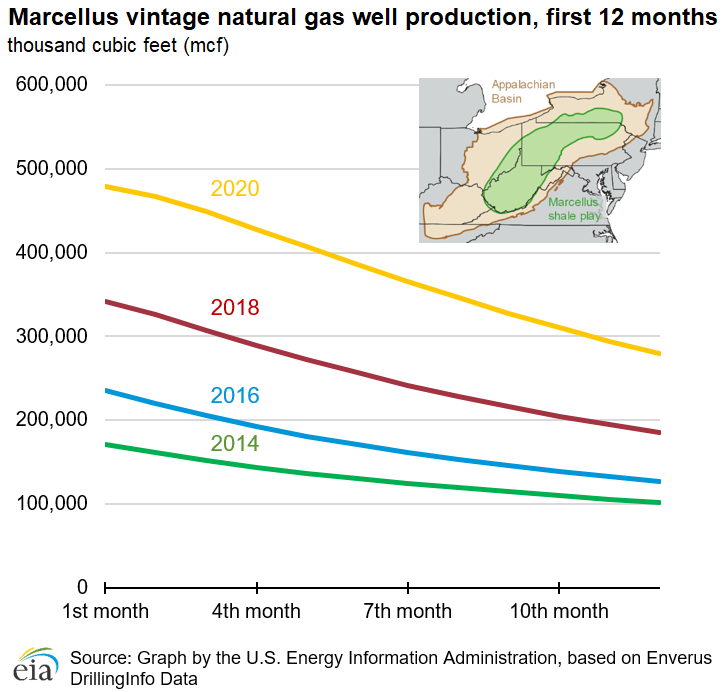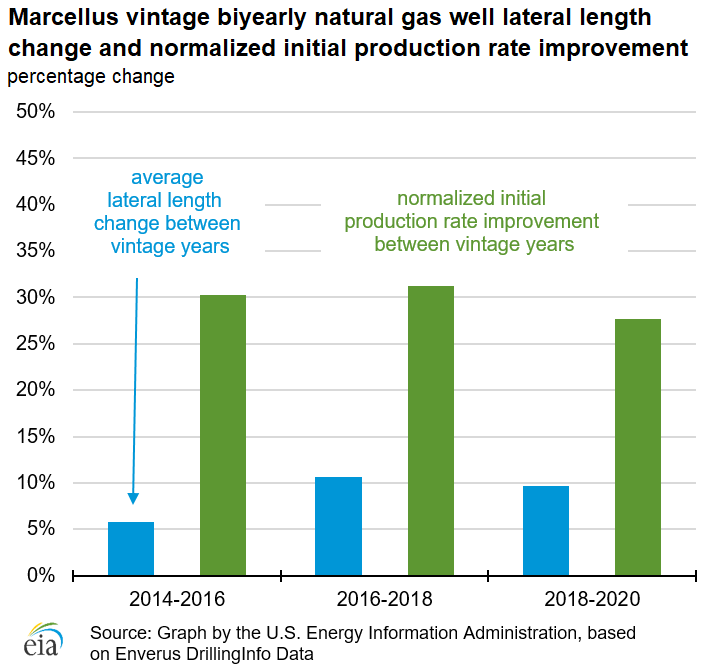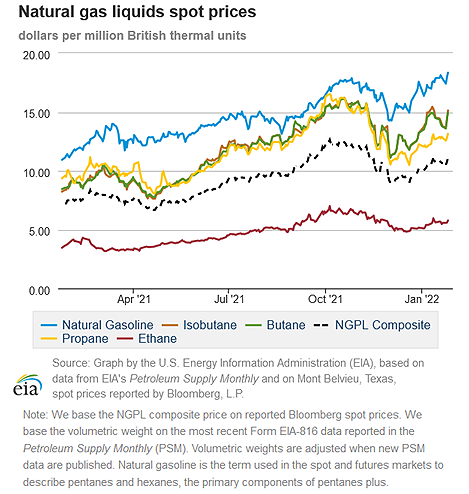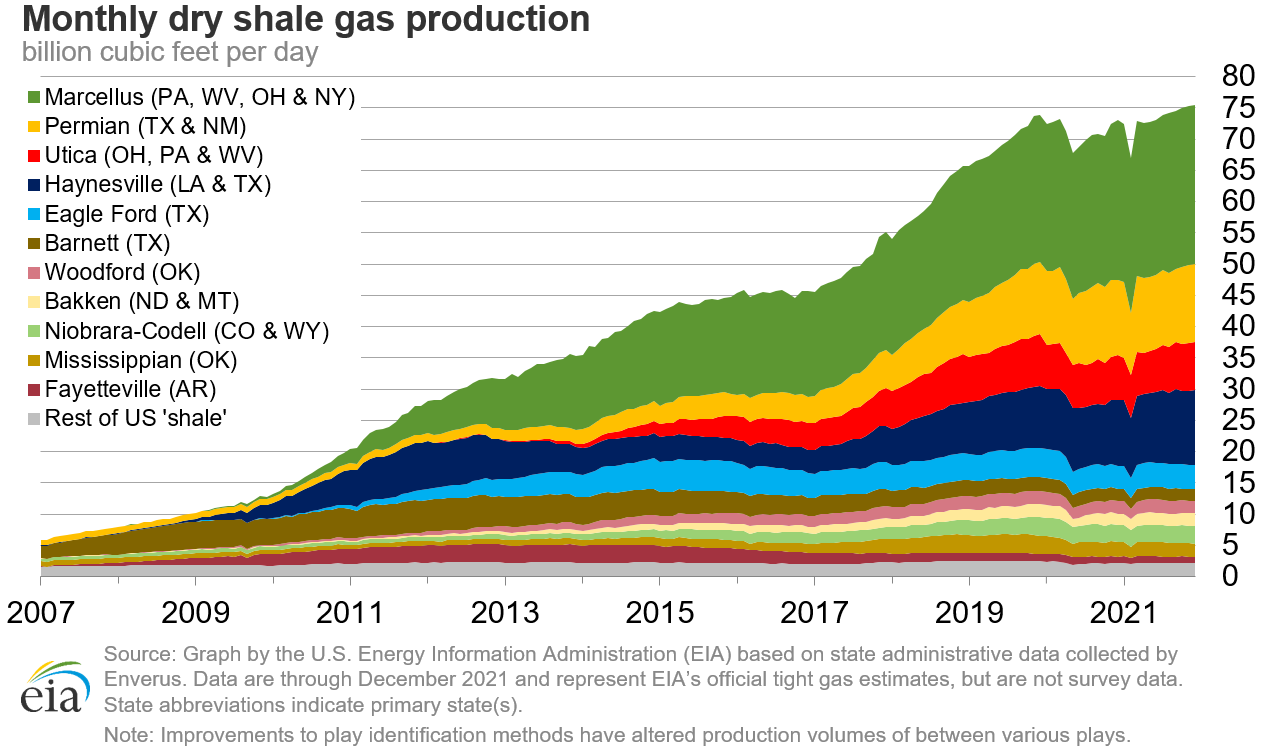In the News:
Average well productivity has increased in the Marcellus Formation
The initial production rate of natural gas from a new well drilled in the Marcellus Formation in the Appalachia Basin increased from about 5.6 million cubic feet per day (MMcf/d) in 2014 to approximately 15.8 MMcf/d in 2020, based on well-level data from Enverus. This increase results primarily from rising initial production rates (usually the first full 30 days of production) of approximately 40% higher every two years since 2014. During this same period, the average length of the horizontal portion of a wellbore, typically referred to as its lateral length, was also increasing. The Marcellus Formation is the largest shale-sourced natural gas-producing formation in the United States and accounts for approximately 21% of all U.S. gross natural gas production.
By design, a horizontal gas well produces from an interval of natural gas-bearing rock as wide as the lateral section of the wellbore is long. With increased lateral length within a given wellbore, the amount of natural gas-bearing rock accessed by the wellbore increases in direct proportion to this additional lateral length. Growth in average lateral length increased between 5.8% and 10.6% every two years from 2014 to 2020; the higher growth rates occurred from 2014 and 2018.
By adjusting, or normalizing, for these longer lateral lengths, we can assess increased well productivity from improved completion designs. Improved completion designs can include different proppant sizes and types, larger or varied water and gel mixes to carry the proppant throughout the induced fractures, and improved hydraulic fracturing techniques that allow better fracture propagation. Based on the normalized well productivity data, we calculate that the initial production rate from the average Marcellus natural gas well has been increasing by approximately 27% to 31% biyearly over the past six years for which complete data are available to build the decline profiles.
Overview:
(For the week ending Wednesday, January 26, 2022)
- Natural gas spot prices fell at most locations this report week (Wednesday, January 19 to Wednesday, January 26). The Henry Hub spot price fell from $4.74 per million British thermal units (MMBtu) last Wednesday to $4.37/MMBtu yesterday.
- International natural gas prices were mixed this report week. Bloomberg Finance, L.P. reports that swap prices for liquefied natural gas (LNG) cargos in East Asia for the balance of the month (January) fell $7.99 to a weekly average of $22.46/MMBtu. At the Title Transfer Facility (TTF) in the Netherlands, the most liquid natural gas spot market in Europe, the day-ahead prices rose an average $2.30 to a weekly average of $28.72/MMBtu. In the same week last year (week ending January 27, 2021), prices in East Asia and at TTF were $8.61/MMBtu and $7.21/MMBtu, respectively.
- The price of the February 2022 NYMEX contract increased 24.6 cents, from $4.031/MMBtu last Wednesday to $4.277/MMBtu yesterday. The price of the 12-month strip averaging February 2022 through January 2023 futures contracts climbed 17 cents to $4.185/MMBtu.
- The net withdrawals from working gas totaled 219 billion cubic feet (Bcf) for the week ending January 21. Working natural gas stocks totaled 2,591 Bcf, which is 11% lower than the year-ago level and 1% lower than the five-year (2017–2021) average for this week.
- The natural gas plant liquids composite price at Mont Belvieu, Texas, fell by 6 cents/MMBtu, averaging $10.73/MMBtu for the week ending January 26. Ethane prices fell 1%, while natural gas prices at the Houston Ship Channel fell 7%, increasing the ethane premium to natural gas by 15%. Propane prices rose 1% following a 2% increase in the Brent crude oil price. Normal butane and isobutane prices fell 2% and 3%, respectively. The natural gasoline price remained relatively unchanged.
- According to Baker Hughes, for the week ending Tuesday, January 18, the natural gas rig count increased by 4 to 113 rigs. The Marcellus gained two rigs, the Haynesville gained one, and one rig was added in an unidentified basin. The number of oil-directed rigs decreased by 1 to 491 rigs. The total rig count now stands at 604, the highest level since April 9, 2020, and 226 rigs more than last year at this time.
Prices/Supply/Demand:
Prices along the Gulf Coast fall as LNG feed gas sets a new weekly record. This report week (Wednesday, January 19 to Wednesday, January 26), the Henry Hub spot price fell 37 cents from $4.74/MMBtu last Wednesday to $4.37/MMBtu yesterday, but it remains approximately 65 cents above the December 2021 average. The South Louisiana natural gas market tightened this report week. Notably, LNG feed gas increased by almost 300 million cubic feet per day (MMcf/d) (4%) over last week to 7.4 billion cubic feet per day (Bcf/d), according to data from IHS Markit. This large increase set a weekly record, and LNG feed gas now accounts for more than half of total natural gas disposition in South Louisiana, exceeding the sum of total consumption and net outflows for the region. Receipts into South Louisiana fell 360 MMcf/d this report week, led by a decline in receipts from the Gulf of Mexico offshore production, which fell by more than 260 MMcf/d (19%).
Prices in the Midwest fall despite colder weather. At the Chicago Citygate, the price fell 39 cents from $4.65/MMBtu last Wednesday, the highest daily price since late November, to $4.26/MMBtu yesterday. IHS Markit reports consumption in the Midwest increased by 5.2 Bcf/d (26%) this report week to a daily average of 25.0 Bcf/d, primarily as a result of higher consumption in the residential and commercial sectors, which increased by 4.0 Bcf/d (34%). Temperatures in the Chicago area averaged 14°F this report week, almost 11°F below normal, resulting in 357 heating degree days (HDDs, a measure of heating demand), compared with last report week, when temperatures averaged 27°F (more than 2°F above normal) and resulted in 265 HDDs. This report week there were colder-than-average temperatures across much of the Eastern two-thirds of the U.S., particularly the Midwest.
Prices decline slightly in the California market, even with cooler temperatures, increased consumption, and almost unchanged supply. The price at PG&E Citygate in Northern California fell 13 cents, down from $5.07/MMBtu last Wednesday to $4.94/MMBtu yesterday. The price at SoCal Citygate in Southern California decreased 22 cents from $5.30/MMBtu last Wednesday to $5.08/MMBtu yesterday, even as NOAA reports temperatures at Riverside, California, inland from Los Angeles, averaged 60°F this report week, resulting in 36 HDDs, 7 HDDs more than last week. Prices also fell in all major supply areas serving Northern California. The price at the Opal Hub in southwest Wyoming, which serves as a source of natural gas into the Northern California market via the Ruby pipeline, fell 3 cents from $4.71/MMBtu last Wednesday to $4.68/MMBtu yesterday. The price at Malin, Oregon, the northern delivery point into the PG&E service territory, fell 2 cents from $4.67/MMBtu last Wednesday to $4.65/MMBtu yesterday. The price at Sumas on the Canada-Washington border, the main pricing point for the Pacific Northwest, fell 2 cents from $4.59/MMBtu last Wednesday to $4.57/MMBtu yesterday. The average temperature for the week in Seattle, Washington, was 40°F this report week, resulting in 170 HDDs, 27 more than last week. IHS Markit estimates weekly average consumption in the Pacific Northwest increased by almost 250 MMcf/d (10%) this report week, and natural gas consumption in California increased by almost 230 MMcf/d (4%).
Prices in the Northeast decrease week over week but remain at high levels as winter weather conditions remain in the region, supporting continued high demand. At the Algonquin Citygate, which serves Boston-area consumers, the price went down $1.98 from $22.69/MMBtu last Wednesday to $20.71/MMBtu yesterday, after reaching a daily high for the week of $24.62/MMBtu on Tuesday. At the Transcontinental Pipeline (Transco) Zone 6 trading point for New York City, the price decreased $4.04 from $15.96/MMBtu last Wednesday to $11.92/MMBtu yesterday. The price at Transco Zone 6 NY reached its highest level so far this winter, $18.11/MMBtu, on Thursday of last week as cold temperatures moved into the region ahead of the weekend. Total natural gas consumption in the Northeast rose by 4.2 Bcf/d (14%) from a week ago, led by a 3.0 Bcf/d increase (17%) in consumption in the residential and commercial sectors.
With continued high natural gas demand in New England due to well-below-normal temperatures, and low natural gas supplies, coal and petroleum have been a consistent part of the electricity supply mix, starting in the second week of January. Petroleum use for electricity generation reached a daily high for the month on January 16, accounting for 22% of the electricity generated, compared with natural gas, which accounted for 32% of the electricity generated on that day. Natural gas accounted for, on average, 53% of the electricity generated in the first six days of January, before coal and petroleum were steadily introduced into the supply mix.
Prices in the Appalachia production region decrease even with high regional demand. The Tennessee Zone 4 Marcellus spot price decreased 23 cents from $4.26/MMBtu last Wednesday to $4.03/MMBtu yesterday. The price at Eastern Gas South in southwest Pennsylvania fell 33 cents from $4.35/MMBtu last Wednesday to $4.02/MMBtu yesterday. Temperatures in the Pittsburgh area were well below normal this week, averaging slightly above 16°F, or 12°F below normal. Consumption was up in the region 2.6 Bcf/d (20%) from 13 Bcf/d the week before and Appalachia production held relatively flat at 32.9 Bcf/d. Natural gas flows out of Appalachia were down this week, helping to offset higher consumption and hold prices at lower levels week over week.
The price discount in the Permian Basin production region relative to Henry Hub increases. The price at the Waha Hub in West Texas, which is located near Permian Basin production activities, fell 65 cents this report week, from $4.69/MMBtu last Wednesday to $4.04/MMBtu yesterday. The Waha Hub traded 33 cents below the Henry Hub price yesterday, compared with last Wednesday when it traded 5 cents below the Henry Hub price. Natural gas production in the Permian Basin fell 3% week over week to 14 Bcf/d as a result of temperatures falling well-below-normal for the week. Nighttime lows reported for the Midland-Odessa area in Texas averaged below freezing throughout the week, with daily averages almost 9°F below normal, leading to freeze-offs. Compared with two weeks ago, however, production in the Permian was up 3%, resulting in flat production over a two-week period.
U.S. total supply of natural gas rises week over week as a result of increased imports. The average total supply of natural gas rose by 0.4% (0.4 Bcf/d) to 100.3 Bcf/d compared with the previous report week, according to data from IHS Markit. This increase was driven by imports from Canada, which increased 10.9% (0.7 Bcf/d) to 7.0 Bcf/d, the highest level since late February 2021. Dry natural gas production decreased by 0.5% (0.5 Bcf/d) compared with the previous report week. LNG pipeline deliveries more than doubled to 0.4 Bcf/d as a result of additional LNG imports into the New England market.
U.S. total consumption of natural gas increases across all sectors compared with the previous report week. Total U.S. consumption of natural gas rose by 14.2% (14.3 Bcf/d) compared with the previous report week, with increases greater than 4% week over week in all sectors except deliveries to LNG export facilities, according to data from IHS Markit. The largest increase was in the residential and commercial sectors, where consumption increased by 21.4% (9.9 Bcf/d) as substantial below-average daytime and nighttime temperatures took hold east of the Rocky Mountains, according to NOAA. Natural gas consumed for power generation climbed by 11.5% (3.3 Bcf/d) week over week, and industrial sector consumption increased by 4.2% (1.1 Bcf/d) week over week. Natural gas exports to Mexico increased 4.6% (0.3 Bcf/d) while natural gas deliveries to LNG export facilities (LNG pipeline receipts) averaged 12.7 Bcf/d, or 0.1 Bcf/d lower than last week.
U.S. LNG exports are up by five vessels this week from last week. Twenty-five LNG vessels (eight from Sabine Pass, five from Corpus Christi, four each from Cameron and Freeport, and two each from Cove Point and Elba Island) with a combined LNG-carrying capacity of 91 Bcf departed the United States between January 20 and January 26, 2022, according to shipping data provided by Bloomberg Finance, L.P.
Storage:
The net withdrawals from storage totaled 219 Bcf for the week ending January 21, compared with the five-year (2017–2021) average net withdrawals of 161 Bcf and last year's net withdrawals of 137 Bcf during the same week. Working natural gas stocks totaled 2,591 Bcf, which is 25 Bcf lower than the five-year average and 308 Bcf lower than last year at this time.
According to The Desk survey of natural gas analysts, estimates of the weekly net change to working natural gas stocks ranged from net withdrawals of 198 Bcf to 231 Bcf, with a median estimate of 217 Bcf.
The average rate of withdrawals from storage is 7% lower than the five-year average so far in the withdrawal season (November through March). If the rate of withdrawals from storage matched the five-year average of 13.8 Bcf/d for the remainder of the withdrawal season, the total inventory would be 1,641 Bcf on March 31, which is 25 Bcf lower than the five-year average of 1,666 Bcf for that time of year.
More storage data and analysis can be found on the Natural Gas Storage Dashboard and the Weekly Natural Gas Storage Report.
See also:
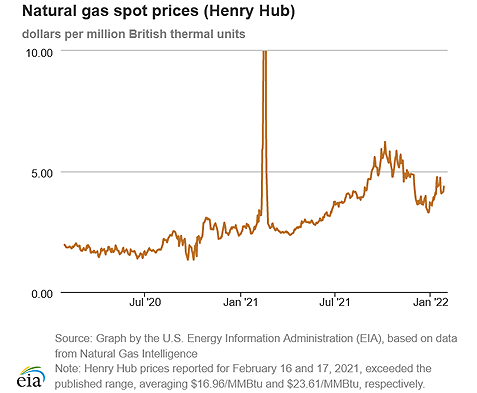
| Spot Prices ($/MMBtu) | Thu, 20-Jan |
Fri, 21-Jan |
Mon, 24-Jan |
Tue, 25-Jan |
Wed, 26-Jan |
|---|---|---|---|---|---|
| Henry Hub |
4.27 |
4.09 |
4.14 |
4.16 |
4.37 |
| New York |
18.11 |
14.48 |
7.11 |
16.71 |
11.92 |
| Chicago |
4.03 |
3.93 |
4.34 |
4.04 |
4.26 |
| Cal. Comp. Avg.* |
4.45 |
4.27 |
4.46 |
4.58 |
4.83 |
| Futures ($/MMBtu) | |||||
| February contract | 3.802 |
3.999 |
4.027 |
4.053 |
4.277 |
| March contract |
3.649 |
3.782 |
3.875 |
3.894 |
4.036 |
| *Avg. of NGI's reported prices for: Malin, PG&E Citygate, and Southern California Border Avg. | |||||
| Source: NGI's Daily Gas Price Index | |||||
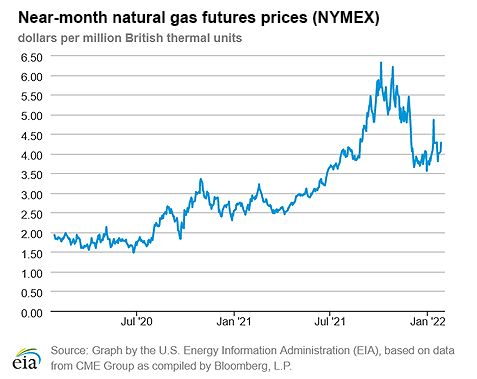
| U.S. natural gas supply - Gas Week: (1/20/22 - 1/26/22) | |||
|---|---|---|---|
Average daily values (billion cubic feet) |
|||
this week |
last week |
last year |
|
| Marketed production | 104.5 |
105.2 |
103.0 |
| Dry production | 93.0 |
93.4 |
92.1 |
| Net Canada imports | 7.0 |
6.3 |
6.2 |
| LNG pipeline deliveries | 0.4 |
0.2 |
0.3 |
| Total supply | 100.3 |
99.9 |
98.6 |
|
Source: Chart by the U.S. Energy Information Administration (EIA), based on data from IHS Markit | |||
| U.S. natural gas consumption - Gas Week: (1/20/22 - 1/26/22) | |||
|---|---|---|---|
Average daily values (billion cubic feet) |
|||
this week |
last week |
last year |
|
| U.S. consumption | 114.3 |
100.1 |
97.2 |
| Power | 32.1 |
28.8 |
27.0 |
| Industrial | 26.1 |
25.0 |
25.2 |
| Residential/commercial | 56.2 |
46.3 |
45.0 |
| Mexico exports | 5.8 |
5.6 |
5.7 |
| Pipeline fuel use/losses | 7.8 |
7.3 |
7.2 |
| LNG pipeline receipts | 12.7 |
12.8 |
10.1 |
| Total demand | 140.6 |
125.8 |
120.2 |
|
Source: Chart by the U.S. Energy Information Administration (EIA), based on data from IHS Markit | |||
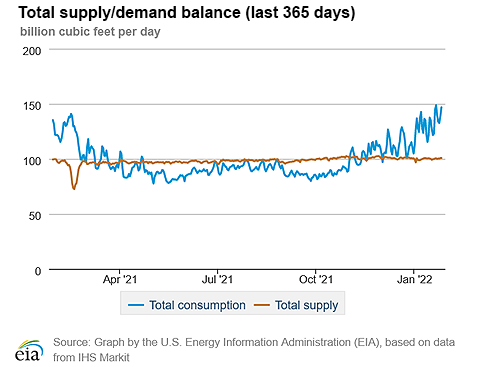
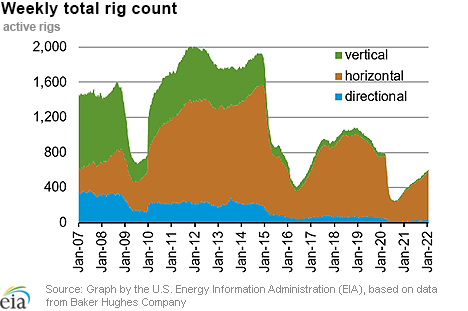
| Rigs | |||
|---|---|---|---|
Tue, January 18, 2022 |
Change from |
||
last week |
last year |
||
| Oil rigs | 491 |
-0.2% |
69.9% |
| Natural gas rigs | 113 |
3.7% |
28.4% |
| Note: Excludes any miscellaneous rigs | |||
| Rig numbers by type | |||
|---|---|---|---|
Tue, January 18, 2022 |
Change from |
||
last week |
last year |
||
| Vertical | 23 |
-8.0% |
27.8% |
| Horizontal | 544 |
0.6% |
60.9% |
| Directional | 37 |
5.7% |
68.2% |
| Source: Chart by the U.S. Energy Information Administration (EIA), based on data from Baker Hughes Company | |||
| Working gas in underground storage | ||||
|---|---|---|---|---|
Stocks billion cubic feet (Bcf) |
||||
| Region | 2022-01-21 |
2022-01-14 |
change |
|
| East | 609 |
669 |
-60 |
|
| Midwest | 701 |
770 |
-69 |
|
| Mountain | 143 |
151 |
-8 |
|
| Pacific | 201 |
201 |
0 |
|
| South Central | 938 |
1,019 |
-81 |
|
| Total | 2,591 |
2,810 |
-219 |
|
|
Source: U.S. Energy Information Administration Form EIA-912, Weekly Underground Natural Gas Storage Report | ||||
| Working gas in underground storage | |||||
|---|---|---|---|---|---|
Historical comparisons |
|||||
Year ago (1/21/21) |
5-year average (2017-2021) |
||||
| Region | Stocks (Bcf) |
% change |
Stocks (Bcf) |
% change |
|
| East | 646 |
-5.7 |
599 |
1.7 |
|
| Midwest | 787 |
-10.9 |
718 |
-2.4 |
|
| Mountain | 171 |
-16.4 |
150 |
-4.7 |
|
| Pacific | 275 |
-26.9 |
227 |
-11.5 |
|
| South Central | 1,019 |
-7.9 |
921 |
1.8 |
|
| Total | 2,899 |
-10.6 |
2,616 |
-1.0 |
|
| Source: U.S. Energy Information Administration Form EIA-912, Weekly Underground Natural Gas Storage Report | |||||
| Temperature – heating & cooling degree days (week ending Jan 20) | ||||||||
|---|---|---|---|---|---|---|---|---|
HDDs |
CDDs |
|||||||
| Region | Current total |
Deviation from normal |
Deviation from last year |
Current total |
Deviation from normal |
Deviation from last year |
||
| New England | 282 |
7 |
79 |
0 |
0 |
0 |
||
| Middle Atlantic | 269 |
6 |
68 |
0 |
0 |
0 |
||
| E N Central | 288 |
-9 |
50 |
0 |
0 |
0 |
||
| W N Central | 304 |
-14 |
58 |
0 |
0 |
0 |
||
| South Atlantic | 188 |
5 |
21 |
1 |
-7 |
1 |
||
| E S Central | 190 |
0 |
21 |
0 |
-2 |
0 |
||
| W S Central | 124 |
-16 |
7 |
1 |
-3 |
1 |
||
| Mountain | 205 |
-27 |
10 |
0 |
0 |
0 |
||
| Pacific | 94 |
-27 |
28 |
0 |
-1 |
0 |
||
| United States | 216 |
-10 |
39 |
0 |
-2 |
0 |
||
|
Source: Chart by the U.S. Energy Information Administration (EIA), based on data from the National Oceanic and Atmospheric Administration Note: HDDs=heating degree days; CDDs=cooling degree days | ||||||||
Average temperature (°F)
7-day mean ending Jan 20, 2022
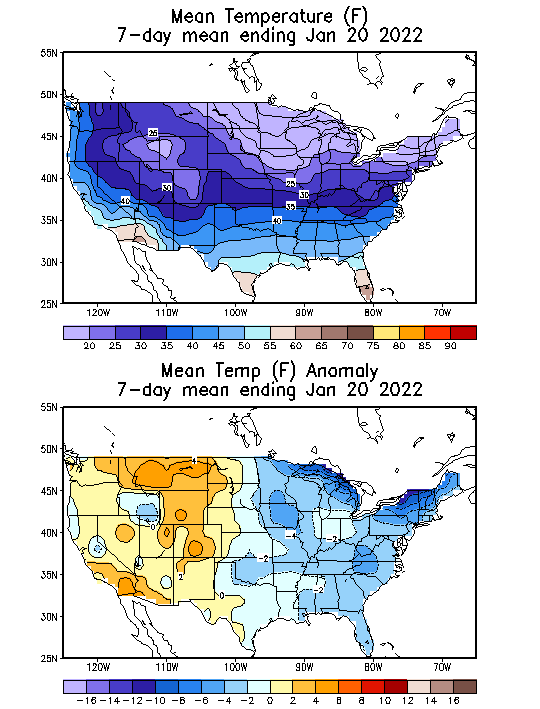
Source: National Oceanic and Atmospheric Administration Note: Image is not available.
Deviation between average and normal (°F)
7-day mean ending Jan 20, 2022

Source: National Oceanic and Atmospheric Administration Note: Image is not available.

